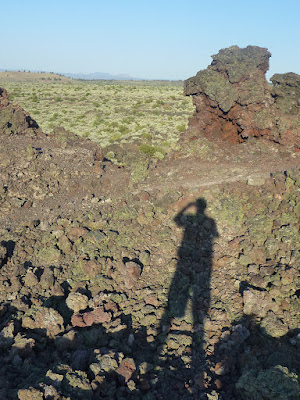 |
| Red-colored rock “glowing” before sunset at the fractured rim of Black Crater in Lava Beds National Monument park |
The
land of burnt-out fires is an area of northeast California that formed long ago, when flowing lava from volcanic eruptions cooled and shaped the landscape. Today, this is
Lava Beds National Monument—a park of lava blankets, caves, catacombs, cones, chimneys and craters.
According to the park service hand-out, there is evidence of over 30 separate lava flows throughout the park. Multiple eruptions from volcanoes and surface vents created the current structure of holes, tubes, caves and underground labyrinths. The hand-out informs:
Eruptions occurring 30-40,000 years ago formed over 700 lava tube caves found in the park. Lava tubes form when streams of hot, flowing lava start to cool. The center of the stream stays hot and continues to flow as the outside begins to cool and harden. The hot lava drains out, leaving a pipe-like cave. Multiple eruptions can stack caves on top of one another, creating multilevel caves. When a lava tube ceiling collapses, it opens access to the cave below.
 |
| Entrance of Skull Cave, 2.4 miles north of the visitor center |
Visitors to Lava Beds typically explore the park underground and between the rocks on its surface. Some of the 700 caves have inspiring names.
Skull Cave with its wide and open entrance, for example, is named for the two human skeletons and bones of pronghorn, bighorn and sheep discovered inside. A special caving hand-out lists selected caves, classified as
least challenging,
moderately challenging and
most challenging. In some caves you can walk completely upright, in others you may have to duck-walk or crawl in some places. Certain caves feature stairs you can use to step down and in. The cave or tube length varies from 150 to 7000 feet. The generally given advice:
Cave softly and safely!
Above ground, you will find short-and-easy as well as long-distance hiking trails leading to caves and other points of interest. The 9.4-mile-long
Lyon Trail connects the Skull Cave area with Hospital Rock near Tule Lake Sump. The 7.5-mile-long
Three Sisters Trail connects the
Indian Well Campground near the visitor center with the Lyons Trail and provides for a loop hike of about eleven miles by including a section of the
Bunchgrass Trail and the
Missing Link Trail. The 3.3-mile-long (one-way)
Whitney Butte Trail leads from the
Merrill Ice Cave parking lots to Whitney Butte. A 1.2-mile-long (one way) trail from the Black Crater parking site provides access to the historic
Thomas-Wright Battlefield between
Hardin Butte and
Black Crater.
The descriptive term “land of burnt-out fires” is derived from what the
Modoc people called the lava-bed lands in their language. A perfect name—over 30,000 years of volcanic history compacted into a few words.The Modoc and their ancestors lived here for over 10,000 years. Some ancestor generations must have witnessed volcanic events; for example, the giant explosion further north that turned Mt. Mazama into Crater Lake. Or volcanic activity to the southwest including eruptions of the nearby
Medicine Lake Volcano or in the
Lassen Volcanic area. The ragged and rough terrain of the lava beds was, to generations of Modoc, a sacred landscape and a resourceful homeland.
 |
| Obsidian—nature's glass—shown along the path from the visitor center to the Mushpot cave |


























